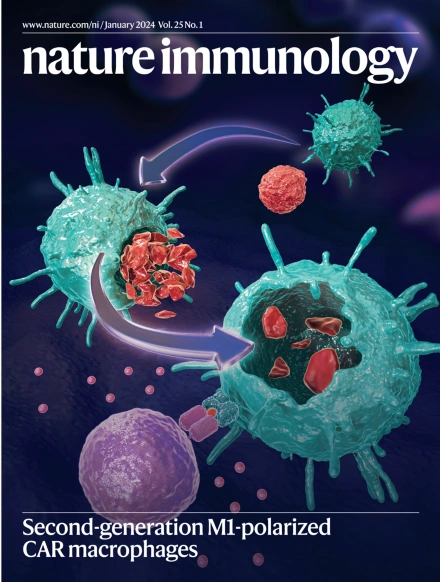利用IRF3作为接头,STING信号从内溶酶体晚期腔室传递给NF-κB。
IF 27.6
1区 医学
Q1 IMMUNOLOGY
引用次数: 0
摘要
NF-κB是激活免疫反应的中枢。胞质DNA激活cGAS-STING通路,通过NF-κB诱导I型干扰素(ifn)和信号传导,从而引发宿主防御和病理性炎症。然而,sting诱导NF-κB活化的机制尚不清楚。在这里,我们报道STING以延迟的方式激活NF-κB,从高尔基体进入内溶酶体室。NF-κB的激活依赖于IFN诱导转录因子IRF3,但不依赖于I型IFN信号传导。这种激活模式在四足动物中是进化保守的。从机制上讲,单体IRF3被募集到STING pS358,与IRF3募集到STING pS366相比,其动力学延迟,从而促进I型IFN反应。IRF3与STING pS358结合诱导转运至内溶酶体晚期区室,支持TRAF6的募集和NF-κB的激活。我们在IRF3中发现了一个促进TRAF6募集的TRAF6结合基序。这项工作定义了STING上的信号表面和IRF3在免疫信号传导中的适配器功能。这些发现表明,STING向NF-κB的信号仅在高尔基体退出和溶酶体降解之间的短时间窗口内激活,可能在稳态和危险感知条件下限制炎症。本文章由计算机程序翻译,如有差异,请以英文原文为准。
STING signals to NF-κB from late endolysosomal compartments using IRF3 as an adaptor.
NF-κB is central for activation of immune responses. Cytosolic DNA activates the cGAS-STING pathway to induce type I interferons (IFNs) and signaling through NF-κB, thus instigating host defenses and pathological inflammation. However, the mechanism underlying STING-induced NF-κB activation is unknown. Here we report that STING activates NF-κB in a delayed manner, following exit from the Golgi to endolysosomal compartments. Activation of NF-κB is dependent on the IFN-inducing transcription factor IRF3 but is independent of type I IFN signaling. This activation pattern is evolutionarily conserved in tetrapods. Mechanistically, the monomer IRF3 is recruited to STING pS358, with delayed kinetics relative to IRF3 recruitment to STING pS366, which promotes type I IFN responses. IRF3 engagement with STING pS358 induces trafficking to late endolysosomal compartments, supporting recruitment of TRAF6 and activation of NF-κB. We identify a TRAF6 binding motif in IRF3 that facilitates recruitment of TRAF6. This work defines a signaling surface on STING and a function for IRF3 as an adaptor in immune signaling. These findings indicate that STING signaling to NF-κB is enabled only within a short time window between exit from the Golgi and lysosomal degradation, possibly limiting inflammation under homeostatic and danger-sensing conditions.
求助全文
通过发布文献求助,成功后即可免费获取论文全文。
去求助
来源期刊

Nature Immunology
医学-免疫学
CiteScore
40.00
自引率
2.30%
发文量
248
审稿时长
4-8 weeks
期刊介绍:
Nature Immunology is a monthly journal that publishes the highest quality research in all areas of immunology. The editorial decisions are made by a team of full-time professional editors. The journal prioritizes work that provides translational and/or fundamental insight into the workings of the immune system. It covers a wide range of topics including innate immunity and inflammation, development, immune receptors, signaling and apoptosis, antigen presentation, gene regulation and recombination, cellular and systemic immunity, vaccines, immune tolerance, autoimmunity, tumor immunology, and microbial immunopathology. In addition to publishing significant original research, Nature Immunology also includes comments, News and Views, research highlights, matters arising from readers, and reviews of the literature. The journal serves as a major conduit of top-quality information for the immunology community.
 求助内容:
求助内容: 应助结果提醒方式:
应助结果提醒方式:


